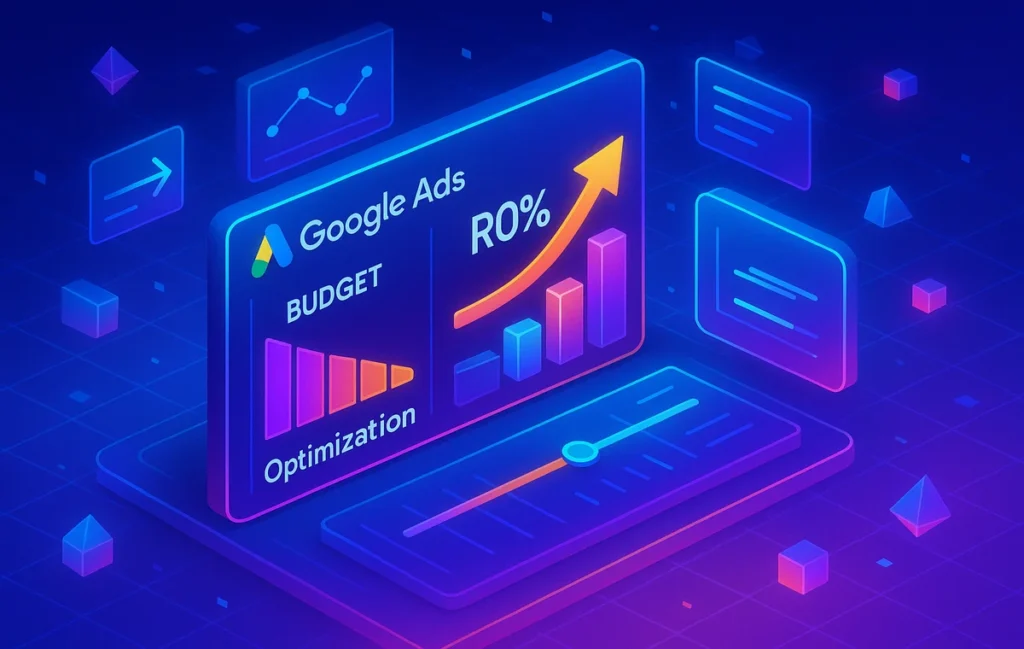💡 Why Lean Budgets Force Smarter Google Ads
Running Google Ads on a limited budget is a high-wire act. Every click matters, and every wasted impression is money burned. For startups, freelancers, and small businesses, this reality often feels intimidating. Yet lean budgets can be a blessing: they force precision, discipline, and creativity. When every dollar must justify itself, marketers are more likely to adopt optimization tactics that drive meaningful ROI instead of chasing vanity impressions.
At NerdChips, we’ve seen small businesses generate stronger ad performance with $500 monthly spends than enterprise campaigns burning $50,000. The difference lies in setup, targeting, and discipline. This guide will show you how to structure smart bidding, apply negative keywords, leverage geo-targeting, enhance ad visibility with extensions, and align ads with high-converting landing pages—all without breaking the bank.
💡 Nerd Tip: Think of your lean budget as a laser, not a floodlight. Precision beats volume every time.
🎯 Smart Bidding vs. Manual Bidding: Choosing the Right Model
Bidding strategy is the foundation of ROI. Manual bidding gives you full control over CPC (cost-per-click), but it also demands constant oversight. Smart bidding, powered by Google’s machine learning, optimizes bids for conversions or conversion value in real time.
For lean budgets, the best approach is often a hybrid. Start with manual bidding to collect data, then shift to smart bidding once you hit at least 30 conversions in a month. This ensures the algorithm has enough learning signals. For example, one SaaS startup running at $20/day switched to Target CPA bidding after 45 conversions. Their cost per lead dropped by 18% in the following two weeks.
But beware of blind trust in automation. Some marketers on X complain:
“Switched to Maximize Conversions. CPC doubled overnight. Zero new leads.”
💡 Nerd Tip: Smart bidding shines when you’ve got clean data. On lean budgets, collect baseline performance manually, then let AI optimize once patterns emerge.
For teams balancing multiple channels, using Top PPC Management Tools can help track both manual and automated strategies side by side.
🔑 Negative Keywords: Cutting the Wasted Spend
Negative keywords are the unsung heroes of budget control. By telling Google which searches not to show your ads for, you avoid paying for irrelevant clicks. For lean budgets, this can save up to 25–40% of ad spend, according to PPC industry benchmarks.
Take a local gym advertising “personal training packages.” Without negative keywords, ads might show for “free workout apps” or “personal trainer salary.” These clicks cost money but will never convert. Adding “free,” “jobs,” or “salary” as negative keywords tightens focus instantly.
💡 Nerd Tip: Build your negative list weekly. Use the Search Terms Report to identify irrelevant clicks and block them before they drain more budget.
Pair this with Best Lead Generation Software to ensure that the traffic you’re paying for actually converts into pipeline, not noise.
🌍 Geo-Targeting: Spend Where It Matters
With lean budgets, geography matters more than ever. Broad national campaigns spread spend too thin. Instead, focus on hyper-local or high-intent regions.
For example, a dental clinic in Paris reduced wasted spend by 35% simply by excluding searches outside its immediate radius. Similarly, a SaaS startup found that leads from North America converted 2.5x better than those from Southeast Asia. By geo-targeting only the U.S. and Canada, they doubled their ROAS (Return on Ad Spend) without increasing budget.
💡 Nerd Tip: Don’t just target where your customers are—exclude where they aren’t. Every exclusion is money saved.
This tactic also aligns with smarter retargeting strategies, especially when paired with Top Video Ad Platforms that let you hyper-focus on audiences by location.
📌 Ad Extensions: Small Additions, Big Impact
Ad extensions expand your search ads with extra links, text, or information. They don’t cost extra but often increase CTR by 10–15%. For lean budgets, that’s like getting free clicks.
Sitelink extensions let you drive traffic to specific offers, callout extensions highlight USPs like “Free Delivery” or “24/7 Support,” and call extensions let mobile users connect instantly. For a small e-commerce store, adding price extensions boosted ad CTR by 22% while keeping CPC flat.
💡 Nerd Tip: Even if you have no budget to increase bids, ad extensions make your ads look bigger and more authoritative—giving you enterprise-level presence at startup prices.
Extensions also support campaign synergy. If your landing pages are optimized (see below), sitelinks can funnel users directly into high-converting experiences.
🖼️ Landing Page Alignment: Closing the Conversion Gap
No matter how optimized your bidding or targeting, if the landing page fails, money is wasted. Aligning ads with dedicated, high-converting pages is the most budget-efficient optimization you can make.
Sending paid clicks to generic homepages is a cardinal sin. Instead, tailor landing pages to match ad promises. If your ad highlights “50% Off First Month,” the landing page should show that headline immediately, not bury it. According to benchmarks, aligned landing pages can lift conversion rates by 30–40% compared to mismatched ones.
💡 Nerd Tip: Test landing page variations with A/B tools. Sometimes a headline change saves more money than a new bidding strategy.
Our guide on Landing Page Builders Compared and How to Build a High-Converting Landing Page dives deeper into tools and frameworks that ensure your ad spend translates into results.
⚡ Ready to Stretch Your Ad Budget Smarter?
Discover PPC tools and landing page builders that maximize ROI even on lean budgets. Start with data-driven bidding, then scale with confidence.
📊 Budget Allocation & Campaign Structuring
When every dollar counts, campaign structure becomes your strongest lever. Many small advertisers spread thin budgets across multiple campaign types—Search, Display, Video—hoping to cover all bases. The result is usually underpowered campaigns with little to show for it.
The smarter approach is to start with Search campaigns targeting high-intent keywords. Search is where users are actively expressing purchase intent (“buy CRM software,” “dentist near me”). By focusing 70–80% of your lean budget here, you ensure money flows toward queries most likely to convert.
From there, allocate 10–20% to Display or Video ads, not for direct conversions but for brand lift and remarketing. For instance, a SaaS company with just $1,000/month split $800 to Search and $200 to remarketing banners. Their ROAS doubled compared to when they tried a 50/50 split across Search and Display.
💡 Nerd Tip: Don’t chase shiny objects. On lean budgets, prioritize campaigns that capture demand, not just generate awareness.
For deeper tool comparisons, see Top Video Ad Platforms for cases where video can support remarketing without draining core spend.
🔄 A/B Testing on Lean Budgets
A/B testing often gets dismissed as “too expensive” for small advertisers. But the truth is, you don’t need thousands of dollars to run meaningful tests—you need focus.
Instead of testing everything, pick one variable at a time. A headline test can reveal whether “Free Trial” or “Start Today” generates higher CTR. Even with 100–200 clicks, you can see directional differences that shape future campaigns. One e-commerce brand with $20/day ad spend tested CTA wording for a month. The winner (“Shop Today – Free Shipping”) improved conversion rates by 12%, a gain that compounded month after month.
💡 Nerd Tip: Run “micro-tests.” Small wins on ad copy, extensions, or landing page headlines accumulate faster than one big risky test.
Pairing A/B tests with insights from Landing Page Builders Compared lets you optimize not just ads but also the destination experience.
📈 Attribution & Conversion Tracking
Without accurate tracking, optimization is just guesswork. Too many advertisers judge success on clicks or impressions, forgetting that what matters is conversions. Google Ads provides powerful conversion tracking, but it only works if you set it up correctly.
For lean budgets, start by connecting Google Ads to Google Analytics 4. This gives you unified visibility into user journeys and cross-device behavior. If you sell offline (e.g., phone calls or in-store visits), set up offline conversion imports to see which clicks actually turn into revenue. According to Google, advertisers who implemented enhanced conversion tracking saw 20% better bid efficiency because smart bidding finally had real outcome data.
💡 Nerd Tip: Always measure to the end of the funnel. A campaign that looks expensive on CPC might be your most profitable once you connect it to lifetime customer value.
For teams that also run broader demand-gen, linking Ads data to Best Lead Generation Software ensures attribution doesn’t stop at form fills but extends into pipeline quality.
🛡️ Risk Management: Avoiding Budget Burn
Lean budgets are fragile. One wrong setting—like broad match keywords with no negatives—can burn through days’ worth of spend in hours. We’ve seen local businesses waste $300 on irrelevant clicks because ads for “plumbing repair” also triggered for “plumbing jobs.”
The first rule of risk management is start narrow, then expand. Use phrase match or exact match until you build confidence. Monitor Search Terms Reports daily in the first week. And always cap your daily budget to an amount you can afford to lose during testing.
💡 Nerd Tip: Think of your budget as oxygen. Guard it against leaks with negatives, match types, and daily caps—or your campaigns will suffocate before they prove themselves.
Marketers on X often share painful stories like:
“Forgot to add negatives. $500 gone in 2 days. 0 leads. Lesson learned: control before scale.”
By tightening risk controls, you not only preserve spend but also give yourself more runway to test and optimize. Tools from Top PPC Management Tools can automate alerts when campaigns spike unexpectedly, saving lean-budget advertisers from expensive mistakes.
📬 Want More Smart AI Tips Like This?
Join our free newsletter and get weekly insights on ads, automation, and lean growth strategies—delivered straight to your inbox. No fluff, just actionable playbooks from NerdChips.
🔐 100% privacy. No noise. Just proven tactics from NerdChips.
🧠 Nerd Verdict
Optimizing Google Ads on a lean budget is about ruthless efficiency. Smart bidding strategies paired with negative keywords cut waste. Geo-targeting ensures money only flows where conversions happen. Ad extensions magnify impact without extra cost, and aligned landing pages turn every click into a real opportunity.
The truth is, lean budgets aren’t a disadvantage—they’re a discipline engine. They force you to refine targeting, creative, and funnel alignment until every dollar carries weight. At NerdChips, we believe this discipline builds stronger marketing habits that scale sustainably when bigger budgets come.
❓ FAQ: Nerds Ask, We Answer
💬 Would You Bite?
If you had just $500 to spend on Google Ads this month, which optimization would you prioritize first—bidding strategies, negative keywords, or landing page improvements?
Share your thoughts—we’d love to compare playbooks. 👇
Crafted by NerdChips for marketers who believe every dollar deserves a return.



